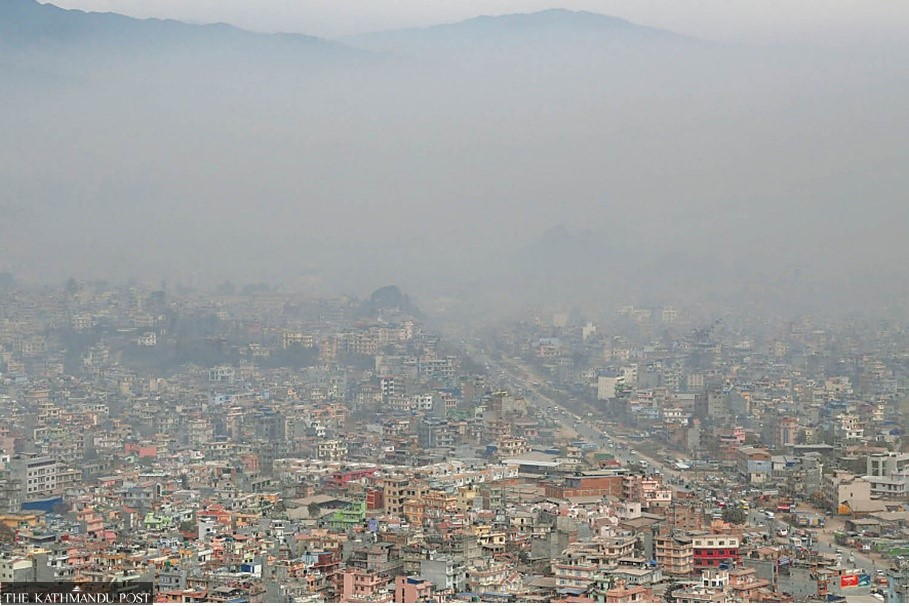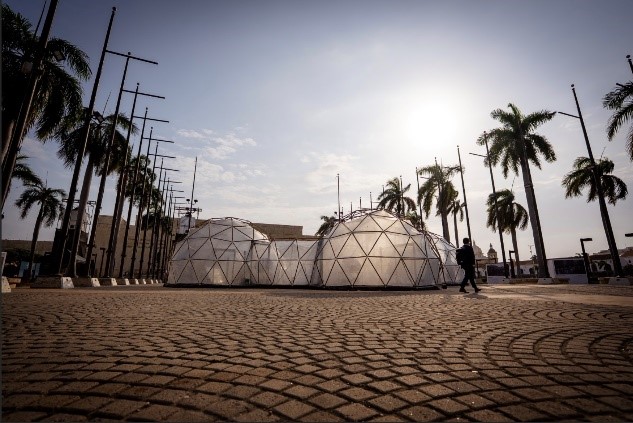
By Abhiskhek Bajracharya, Intern
Apr 09, 2025
Second Global Conference on Air Pollution and Health
Second Global Conference on Air Pollution and Health
(March 25th – 27th, 2025)

Fig 1 - Air pollution in Kathmandu (Credit: The Kathmandu Post)
Air pollution is one of the most harmful forms of pollution. It is the contamination of air by various hazardous pollutants such as (Particulate Matter) PM 2.5, PM 10, Carbon Dioxide (CO2), Carbon Monoxide (CO), Methane, Nitrous Oxides (NOx), Sulfur Oxides (SOx), these pollutants negatively impact on the environment and human health. These pollutants affect human health by interfering in the blood stream, penetrating deep into the lungs, replacing oxygen from the blood stream. It globally accounts for 8 million deaths annually, mostly affecting vulnerable groups, especially children, women, old, aged people. In context of Nepal, life expectancy of Nepalese people has decreased by 3.4 years due to hazardous air (Report from Air Quality Life Index-2024). Along with death of 48,500 people in the year 2021 due to air pollution (State of Global Air 2024 reports).
To address the alarming mortality rate and other health effects from air pollution, the First Global Conference on Air Pollution and Health was held in need of urgent action to tackle the air pollution and its effects on human health and addressing critical issues such as air quality monitoring, health sector emissions, children’s health, climate change, outdoor workers' exposure, and non-communicable diseases, emphasizing the need for global collaboration in tackling air pollution. This article gives a summary of the Second Global Conference on Air Pollution and Health.
The first day (25th March 2025) of the Second Global Conference on Air Pollution and Health, initiated with a call to action: Tackling air pollution as one of the world’s most urgent and solvable public health crises, backed by the World Bank’s Global Flagship Report on Air Pollution which ensured reducing global exposure to PM 2.5 concentration above 25 µg/m³ by 2040 by 50%, being feasible and economically viable through collective action for strengthening air quality governance. It was highlighted that 99.82% of global land is exposed to PM 2.5 and there’s need for an integrated approach to pollutants.
Martina Otto, Head of the CCAC (Climate and Clean Air Coalition) Secretariat, led a discussion on reducing super pollutants, featuring success story from Colombia, Medellin, where investments in electric public transport and green corridors helped cut PM 2.5 pollutions by nearly 40% and lower the urban temperature by over 2°C.
CCAC’s sponsored pollution pods were showcased for its immersive installations along with a Clean Air Tunnel by Clean Air Fund featuring urban air quality innovation, and an animated journey from pollution to clean air, reinforcing the urgency of coordinated action on air pollution and climate change.

Fig 2 - Pollution Pods that simulate real-world air pollution by CCAC (Climate and Clean Air Coalition)
The second day (26th March 2025) focused on solutions, ambitions, innovation, and strategies for clean air. The role of governments in designing effective policies, fostering collaboration, and leveraging data-driven tools for impactful policy outcomes were discussed. Martina Otto (CCAC) introduced Clean Air Flagship, structured around five goals (Fig 2). Use of innovative software tools such as AirQ+, CaRBonH, and GreenUr in assessing air pollution’s health impacts were also discussed. Another session addressed the health impacts of open waste burning, revealing that 40% of 2 billion tonnes of global municipal solid waste is openly burned, contributing to super pollutants like methane and black carbon, along with the World Bank’s Global Flagship Report on Air Pollution presenting the “35-by-35” initiative, which aimed to reduce PM 2.5 levels to 35 µg/m³ by 2035 in South Asia. A speaker from South African Medical Research Council, emphasized that 70% of waste in low- and middle-income countries is recyclable, but due to poor waste management and data gaps affects the circular economy efforts.

Figure 3: Clean Air Flagship Goals
The third day (27th March 2025) was the day where the attendees such as CCAC, World Bank, Global Climate and Health Alliance, World Health Organization, ICIMOD, etc. committed for clean air by mobilizing action for lasting impact and reaffirming the commitment to WHO target of reducing air pollution by 50% by 2040.
Dr. Sunkaru Touray from the Permian Health Lung Institute in Gambia stressed about the health impacts of air pollution on his patients and highlighted collaborative efforts with the government to install sensors and reference-grade monitors, which would drive data-based initiatives. The sessions from previous days were summarized which emphasized the importance of evidence-based policies, cross-sector coordination, equity considerations, capacity building, and air quality financing. Need for action at all levels from individual to global efforts and enhancing collaboration between countries to combat transboundary pollution was emphasized.
In conclusion, this conference showcased the status of various countries and their commitment to reducing air pollution by half. The issue of air pollution transcends national boundaries, affecting millions regardless of borders. 
Nepal, facing the impact of transboundary pollution from neighboring countries, is struggling with persistently high levels of air pollution. In 2024, the average PM 2.5 concentration was 42.81 µg/m³ which is 8.6 times above the WHO’s annual guideline value. Cities like Kathmandu, Patan, and Bhaktapur are blanketed in toxic air, threatening the health of children, the elderly, and vulnerable populations, with increased risks of respiratory and cardiovascular diseases. While the "35-by-35" initiative aims to reduce pollution by 2035, Nepal cannot afford to wait that long as the damage is already being felt. Wildfires are further adding to the crisis, worsening air quality. Immediate action is crucial, including stricter environmental regulations, enhanced pollution control efforts, and early warning systems with rapid response teams. Clean air is a basic human right, and Nepal must act now to protect its citizens and ensure a healthier future.























